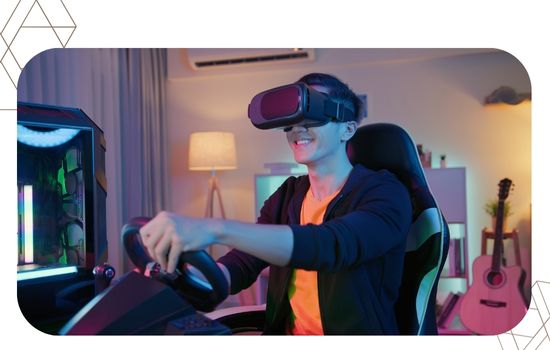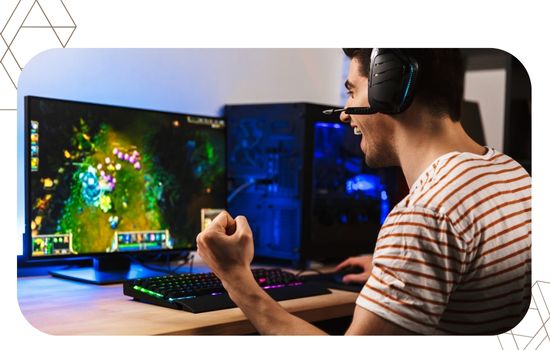Advertisements
The Evolution of car simulators It is a fascinating journey that combines technology, engineering and passion for driving.

From early rudimentary experiments in university labs to today's advanced virtual reality and physics platforms, this transformation has redefined learning, entertainment, and the automotive industry.
Summary: In this article, you'll discover how simulators were born, what technological advances drove them, how they're currently used in professional training and gaming, and where their future is headed with artificial intelligence and mixed realities.
The first steps: from training tools to educational innovation
Driving simulators were originally designed with a clear objective: train drivers in a safe environment.
In the 1960s, companies such as General Motors and Ford began experimenting with mechanical cockpits that replicated basic automobile controls.
Advertisements
Although limited, these prototypes marked the beginning of a new era.
During the 1980s, with the arrival of microprocessors, a fundamental leap was made.
Universities and research centers, such as the MIT and the University of Iowa, began developing simulators that integrated computer visuals and physical feedback.
He first fully digital driving simulator It was used to study human behavior in response to alcohol and fatigue while driving.
The Evolution of car simulators At this stage, development was slow but crucial: it laid the foundations for a technology that, decades later, would be indispensable in sectors as diverse as aviation, road safety education, and professional motorsports.
Decades of increasing realism: from digital to sensorial
In the 90s, the revolution came with the development of dedicated graphics cards.
Simulators have ceased to be exclusively research tools and have become accessible to the public.
Titles like Gran Turismo and Need for Speed popularized virtual driving, driving an industry that today exceeds $3.2 billion annually, according to Statista (2024).
But beyond entertainment, technical precision began to matter.
Companies began to invest in systems of hydraulic movement and haptic sensors capable of accurately reproducing G-forces, engine vibrations and asphalt friction.
Today, these advances allow professional drivers to train with such a high level of realism that they can memorize entire circuits without ever setting foot on the track.
An example of this is the Mercedes-AMG Petronas simulator, with a latency of less than 30 milliseconds and 8K visual fidelity.
From entertainment to professional performance
The line between game and simulation has blurred.
Today, the Evolution of car simulators has led to them being high-performance tools.
Formula 1 teams, rally teams and sports car manufacturers use platforms such as rFactor Pro either iRacing to analyze aerodynamics, traction and driver ergonomics.
A notable example is Toyota Gazoo Racing's use of its advanced simulator in Japan, where engineers and drivers work together on virtual tests before producing physical parts.
Thanks to these systems, development times and manufacturing costs are reduced by up to 40%.
This convergence demonstrates how technology, once exclusive to entertainment, has become a strategic tool in automotive engineering.
The virtual reality revolution and the automotive metaverse
In recent years, virtual reality (VR) and augmented reality (AR) have redefined the digital driving experience.
With devices like the Meta Quest 3 or the Apple Vision Pro, users can feel like they are actually inside a car, with panoramic vision, spatial sound, and real-time physical response.
This stage of the Evolution of car simulators not only improves immersion, but opens up new educational and business opportunities.
Driving schools are using VR simulators to train young drivers and reduce accidents, while manufacturers such as BMW and Audi are developing virtual prototypes that are then built in smart factories.
The trend is oriented towards the concept of automotive metaverse, where each model can be virtually tested, configured, and experienced before being manufactured.
It is a silent, but powerful revolution.
Artificial intelligence: the copilot of the future
The integration of the artificial intelligence (AI) has been a recent turning point.
Thanks to machine learning, simulators now analyze driving style, detect errors, and offer personalized feedback.
Companies like Bosch and Waymo have developed AI-powered simulation platforms to train autonomous vehicles in virtual environments.
These environments reproduce millions of urban, climate, and traffic scenarios without human risk, accelerating the development of global autonomous driving.
You could say that AI is the “invisible co-pilot” that learns with every turn and turns every mistake into knowledge.
Just as a coach watches an athlete's every move, AI in driving simulators identifies patterns, predicts risks, and optimizes decisions.
A comparative look: technical evolution
| Decade | Dominant technology | Key feature | Main application |
|---|---|---|---|
| 1960-1980 | Analog mechanics | Static booths | Basic training |
| 1990 | 3D graphics and sensors | Visual realism | Video games |
| 2000 | Dynamic platforms | Haptic feedback | Professional simulation |
| 2010-2020 | Virtual reality and AI | Total immersion | Advanced training |
| 2025 | Mixed reality + cloud | Smart integration | Autonomous driving |

Read more: History of the first video games
Accessibility: Simulation for Everyone
One of the most interesting transformations is the democratization of simulation.
What once cost millions of dollars can now be achieved with a home computer costing just a few hundred.
Platforms such as Assetto Corsa Competizione either BeamNG.drive offer ultra-realistic experiences with haptic feedback steering wheels and dynamic environments.
This access has fueled global communities of sim racers—virtual drivers—who compete professionally from home.
Thanks to cloud connectivity, these players train and participate in international tournaments, even sharing telemetry data in real time.
The Evolution of car simulators It has stopped being a story about machines and has become a story about people seeking precision, emotion, and digital connection.
What does the future hold?
The future points towards the total fusion between reality and simulation.
Upcoming simulators are expected to combine augmented reality, advanced haptics and biometric sensors, capable of measuring the driver's heart rate, breathing and concentration.
In addition, manufacturers are already exploring cloud-connected simulation systems, which allow vehicles to be tested in artificial intelligence-generated urban environments with real-life traffic.
It's as if every driver had access to their own virtual testing lab.
Could the day come when driving in a simulator is indistinguishable from driving in real life? All signs point to yes, and perhaps sooner than we imagine.
Conclusion
The Evolution of car simulators It is an example of human ingenuity applied to safety, training and fun.
What began as an academic experiment is now driving entire industries and redefining the way we understand mobility.
Technological advancements not only improve graphics and realism, but also the way people learn, compete, and interact with driving.
By 2025, these systems are no longer a luxury: they are an essential tool for a safer, smarter, and more sustainable future.
Read more: Survival games: why they fascinate gamers so much
Frequently Asked Questions
1. Can car simulators replace real practice?
Not entirely. Although simulators offer a very precise learning environment, real-life driving involves unpredictable factors that cannot yet be replicated with the 100%.
2. What is the main advantage of using a professional simulator?
It allows you to train safely, improve reflexes, practice in different weather conditions, and reduce maintenance costs.
3. What is the difference between a game simulator and a professional one?
Entertainment simulators prioritize fun and accessibility; professional simulators, on the other hand, seek physical accuracy, telemetry data, and technical analysis.
4. What is the next big thing in car simulation?
The full integration of mixed reality, artificial intelligence, and cloud connectivity, creating virtual driving ecosystems with continuous machine learning.



